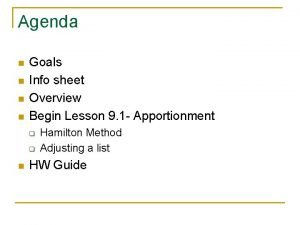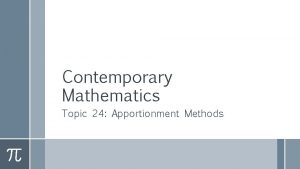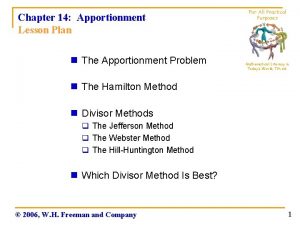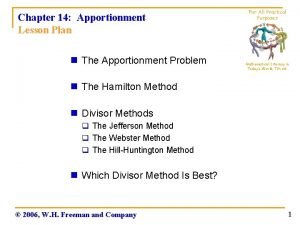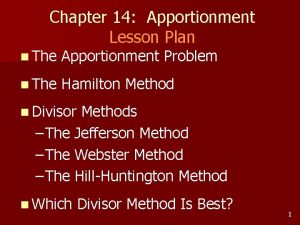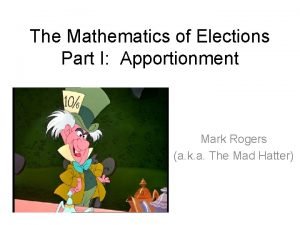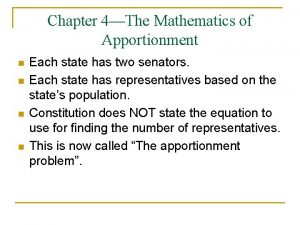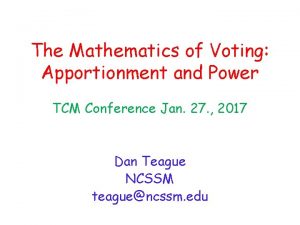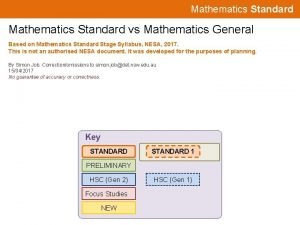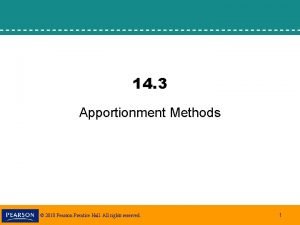4 The Mathematics of Apportionment 4 1 Apportionment
































- Slides: 32


4 The Mathematics of Apportionment 4. 1 Apportionment Problems 4. 2 Hamilton’s Method and the Quota Rule 4. 3 The Alabama and Other Paradoxes 4. 4 Jefferson’s Method 4. 5 Adam’s Method 4. 6 Webster’s Method Copyright © 2010 Pearson Education, Inc. Excursions in Modern Mathematics, 7 e: 4. 1 - 2

Apportionment Without a doubt, the most important and heated debate at the Constitutional Convention concerned the makeup of the legislature. The small states wanted all states to have the same number of representatives; the larger states wanted some form of proportional representation. The Constitutional compromise, known as the Connecticut Plan, was a Senate, in which every state has two senators, and a House of Representatives, in which each state has a number of representatives that is a function of its population. Copyright © 2010 Pearson Education, Inc. Excursions in Modern Mathematics, 7 e: 4. 1 - 3

Apportionment While the Constitution makes clear that seats in the House of Representatives are to be allocated to the states based on their populations (“According to their respective Numbers”), it does not prescribe a specific method for the calculations. Undoubtedly, the Founding Fathers felt that this was a relatively minor detail–a matter of simple arithmetic that could be easily figured out and agreed upon by reasonable people. Copyright © 2010 Pearson Education, Inc. Excursions in Modern Mathematics, 7 e: 4. 1 - 4

Apportionment Certainly it was not the kind of thing to clutter a Constitution with or spend time arguing over in the heat of the summer. What the Founding Fathers did not realize is that Article I, Section 2, set the Constitution of the United States into a collision course with a mathematical iceberg known today (but certainly not then) as the apportionment problem. Copyright © 2010 Pearson Education, Inc. Excursions in Modern Mathematics, 7 e: 4. 1 - 5

Apportionment Problems Obviously, the word apportion is the key word in this chapter. There are two critical elements in the dictionary definition of the word: (1) We are dividing and assigning things, and (2) we are doing this on a proportional basis and in a planned, organized fashion. We will start this section with a pair of examples that illustrate the nature of the problem we are dealing with. These examples will raise several questions but not give any answers. Most of the answers will come later. Copyright © 2010 Pearson Education, Inc. Excursions in Modern Mathematics, 7 e: 4. 1 - 6

Example 4. 1 Kitchen Capitalism Mom has a total of 50 identical pieces of candy (let’s say caramels), which she is planning to divide among her five children (this is the division part). Like any good mom, she is intent on doing this fairly. Of course, the easiest thing to do would be to give each child 10 caramels–by most standards, that would be fair. Mom, however, is thinking of the long-term picture–she wants to teach her children about the value of work and about the relationship between work and reward. Copyright © 2010 Pearson Education, Inc. Excursions in Modern Mathematics, 7 e: 4. 1 - 7

Example 4. 1 Kitchen Capitalism This leads her to the following idea: She announces to the kids that the candy is going to be divided at the end of the week in proportion to the amount of time each of them spends helping with the weekly kitchen chores–if you worked twice as long as your brother you get twice as much candy, and so on (this is the due and proper proportion part). Unwittingly, mom has turned this division problem into an apportionment problem. Copyright © 2010 Pearson Education, Inc. Excursions in Modern Mathematics, 7 e: 4. 1 - 8

Example 4. 1 Kitchen Capitalism At the end of the week, the numbers are in. Table 4 -1 shows the amount of work done by each child during the week. (Yes, mom did keep up-to-the-minute records!) Copyright © 2010 Pearson Education, Inc. Excursions in Modern Mathematics, 7 e: 4. 1 - 9

Example 4. 1 Kitchen Capitalism According to the ground rules, Alan, who worked 150 out of a total of 900 minutes, should get 8 1/3 pieces. Here comes the problem: Since the pieces of candy are indivisible, it is impossible for Alan to get his pieces–he can get 8 pieces (and get shorted) or he can get 9 pieces (and someone else will get shorted). Copyright © 2010 Pearson Education, Inc. Excursions in Modern Mathematics, 7 e: 4. 1 - 10

Example 4. 1 Kitchen Capitalism A similar problem occurs with each of the other children. Betty’s exact fair share should be 4 1/3 pieces; Connie’s should be 9 11/18 pieces; Doug’s, 11 1/3 pieces; and Ellie’s, 16 7/18 pieces. Because none of these shares can be realized, an absolutely fair apportionment of the candy is going to be impossible. What should mom do? Copyright © 2010 Pearson Education, Inc. Excursions in Modern Mathematics, 7 e: 4. 1 - 11

Apportionment Problem Example 4. 1 shows all the elements of an apportionment problem–there are objects to be divided (the pieces of candy), and there is a proportionality criterion for the division (number of minutes worked during the week). We will say that the pieces of candy are apportioned to the kids, and we will describe the final solution as an apportionment (Alan’s apportionment is x pieces, Betty’s apportionment is y pieces, etc. ). Let’s now consider a seemingly different apportionment problem. Copyright © 2010 Pearson Education, Inc. Excursions in Modern Mathematics, 7 e: 4. 1 - 12

Example 4. 2 The Intergalactic Congress of Utopia It is the year 2525, and all the planets in the Utopia galaxy have finally signed a peace treaty. Five of the planets (Alanos, Betta, Conii, Dugos, and Ellisium) decide to join forces and form an Intergalactic Federation. The Federation will be ruled by an Intergalactic Congress consisting of 50 “elders, ” and the 50 seats in the Intergalactic Congress are to be apportioned among the planets according to their respective populations. Copyright © 2010 Pearson Education, Inc. Excursions in Modern Mathematics, 7 e: 4. 1 - 13

Example 4. 2 The Intergalactic Congress of Utopia The population data for each of the planets (in billions) are shown in Table 4 -2. Based on these population figures, what is the correct apportionment of seats to each planet? We’ll get back to this later. . . Copyright © 2010 Pearson Education, Inc. Excursions in Modern Mathematics, 7 e: 4. 1 - 14

Apportionment Problem Example 4. 2 is another example of an apportionment problem–here the objects being divided are the 50 seats in the Intergalactic Congress, and the proportionality criterion is population. But there is more to it than that. The observant reader may have noticed that the numbers in Examples 4. 1 and 4. 2 are identical– it is only the framing of the problem that has changed. Mathematically speaking, Examples 4. 1 and 4. 2 are one and the same apportionment problem–solve either one and you have solved both! Copyright © 2010 Pearson Education, Inc. Excursions in Modern Mathematics, 7 e: 4. 1 - 15

Example 4. 3 The Congress of Parador is a small republic located in Central America and consists of six states: Azucar, Bahia, Cafe, Diamante, Esmeralda, and Felicidad (A, B, C, D, E, and F for short). There are 250 seats in the Congress, which, according to the laws of Parador, are to be apportioned among the six states in proportion to their respective populations. What is the “correct” apportionment? Table 4 -3 shows the population figures for the six states according to the most recent census. Copyright © 2010 Pearson Education, Inc. Excursions in Modern Mathematics, 7 e: 4. 1 - 16

Example 4. 3 The Congress of Parador The first step we will take to tackle this apportionment problem is to compute the population to seats ratio, called the standard divisor (SD). In the case of Parador, the standard divisor is 12, 500, 000/250 = 50, 000. The standard divisor tells us that in Parador, each seat in the Congress corresponds to 50, 000 people. Copyright © 2010 Pearson Education, Inc. Excursions in Modern Mathematics, 7 e: 4. 1 - 17

Example 4. 3 The Congress of Parador We can now use this yardstick to find the number of seats that each state should get by the proportionality criterion– all we have to do is divide the state’s population by 50, 000. For example, take state A. If we divide the population of A by the standard divisor, we get 1, 646, 000/50, 000 = 32. 92. This number is called the standard quota (sometimes also known as the exactor fair quota) of state A. Copyright © 2010 Pearson Education, Inc. Excursions in Modern Mathematics, 7 e: 4. 1 - 18

Example 4. 3 The Congress of Parador If seats in the Congress could be apportioned in fractional parts, then the fair and exact apportionment to A would be 32. 92 seats, but, of course, this is impossible–seats in the Congress are indivisible objects! Thus, the standard divisor of 32. 92 is a standard that we cannot meet, although in this case we might be able to come close to it: The next best solution might be to apportion 33 seats to state A. Hold that thought! Copyright © 2010 Pearson Education, Inc. Excursions in Modern Mathematics, 7 e: 4. 1 - 19

Example 4. 3 The Congress of Parador Using the standard divisor SD = 50, 000, we can quickly find the standard quotas of each of the other states. These are shown in Table 4 -4 (rounded to two decimal places). Notice that the sum of the standard quotas equals 250, the number of seats being apportioned. Copyright © 2010 Pearson Education, Inc. Excursions in Modern Mathematics, 7 e: 4. 1 - 20

Example 4. 3 The Congress of Parador Once we have computed the standard quotas, we get to the heart of the apportionment problem: How should we round these quotas into whole numbers? At first glance, this seems like a dumb question. After all, we all learned in school how to round decimals to whole numbers–round down if the fractional part is less than 0. 5, round up otherwise. This kind of rounding is called rounding to the nearest integer, or simply conventional rounding. Copyright © 2010 Pearson Education, Inc. Excursions in Modern Mathematics, 7 e: 4. 1 - 21

Example 4. 3 The Congress of Parador Unfortunately, conventional rounding will not work in this example, and Table 4 -5 shows why not–we would end up giving out 251 seats in the Congress, and there are only 250 seats to give out! (Add an extra seat, you say? Sorry, this is not a banquet. The number of seats is fixed–we don’t have the luxury of adding or subtracting seats!) Copyright © 2010 Pearson Education, Inc. Excursions in Modern Mathematics, 7 e: 4. 1 - 22

Example 4. 3 The Congress of Parador So now that we know that conventional rounding of the standard quotas is not going to give us the solution to the apportionment of Parador’s Congress, what do we try next? For now, we leave this example–a simple apportionment problem looking for a simple solution–with no answers (but, we hope, with some gained insight!). Our search for a good solution to this problem will be theme of our journey through the rest of this chapter. Copyright © 2010 Pearson Education, Inc. Excursions in Modern Mathematics, 7 e: 4. 1 - 23

Apportionment: Basic Concepts and Terminology Apportionment problems can arise in a variety of real-life applications–dividing candy among children (see Example 4. 1), assigning nurses to shifts (see Exercise 4. 4), assigning buses to routes (see Exercise 4. 3), and so on. But the gold standard for apportionment applications is the allocation of seats in a legislature, and thus it is standard practice to borrow the terminology of legislative apportionment and apply it to apportionment problems in general. Copyright © 2010 Pearson Education, Inc. Excursions in Modern Mathematics, 7 e: 4. 1 - 24

Apportionment: Basic Concepts and Terminology The basic elements of every apportionment problem are as follows: The “states” This is the term we will use to describe the parties having a stake in the apportionment. Unless they have specific names (Azucar, Bahia, etc. ), we will use A 1, A 2, …, AN, to denote the states. Copyright © 2010 Pearson Education, Inc. Excursions in Modern Mathematics, 7 e: 4. 1 - 25

Apportionment: Basic Concepts and Terminology The “seats” This term describes the set of M identical, indivisible objects that are being divided among the N states. For convenience, we will assume that there are more seats than there are states, thus ensuring that every state can potentially get a seat. (This assumption does not imply that every state must get a seat!) Copyright © 2010 Pearson Education, Inc. Excursions in Modern Mathematics, 7 e: 4. 1 - 26

Apportionment: Basic Concepts and Terminology The “populations” This is a set of N positive numbers (for simplicity we will assume that they are whole numbers) that are used as the basis for the apportionment of the seats to the states. We will use p 1, p 2, …, p. N, to denote the state’s respective populations and P to denote the total population P = p 1 + p 2 +…+ p. N). Copyright © 2010 Pearson Education, Inc. Excursions in Modern Mathematics, 7 e: 4. 1 - 27

Apportionment: Basic Concepts and Terminology Two of the most important concepts of the chapter are the standard divisor and the standard quotas. We can now formally define these concepts using our new terminology and notation. Copyright © 2010 Pearson Education, Inc. Excursions in Modern Mathematics, 7 e: 4. 1 - 28

Apportionment: Basic Concepts and Terminology The standard divisor(SD) This is the ratio of population to seats. It gives us a unit of measurement (SD people = 1 seat) for our apportionment calculations. Copyright © 2010 Pearson Education, Inc. Excursions in Modern Mathematics, 7 e: 4. 1 - 29

Apportionment: Basic Concepts and Terminology The standard quotas The standard quota of a state is the exact fractional number of seats that the state would get if fractional seats were allowed. We will use the notation q 1, q 2, …, q. N to denote the standard quotas of the respective states. To find a state’s standard quota, we divide the state’s population by the standard divisor. (In general, the standard quotas can be expressed as fractions or decimals–round them to two or three decimal places. ) Copyright © 2010 Pearson Education, Inc. Excursions in Modern Mathematics, 7 e: 4. 1 - 30

Apportionment: Basic Concepts and Terminology Upper and lower quotas The lower quota is the standard quota rounded down and the upper quota is the standard quota rounded up. In the unlikely event that the standard quota is a whole number, the lower and upper quotas are the same. We will use L’s to denote lower quotas and U’s to denote upper quotas. For example, the standard quota q 1 = 32. 92 has lower quota L 1 = 32 and upper quota U 1 = 33. Copyright © 2010 Pearson Education, Inc. Excursions in Modern Mathematics, 7 e: 4. 1 - 31

Apportionment Methods Our main goal in this chapter is to discover a “good” apportionment method–a reliable procedure that (1) will always produce a valid apportionment (exactly M seats are apportioned) and (2) will always produce a “fair” apportionment. In this quest we will discuss several different methods and find out what is good and bad about each one. Copyright © 2010 Pearson Education, Inc. Excursions in Modern Mathematics, 7 e: 4. 1 - 32
 Webster apportionment method
Webster apportionment method Absolute unfairness calculator
Absolute unfairness calculator Allocation apportionment and absorption of overheads
Allocation apportionment and absorption of overheads Dot
Dot Biện pháp chống mỏi cơ
Biện pháp chống mỏi cơ Phản ứng thế ankan
Phản ứng thế ankan Trời xanh đây là của chúng ta thể thơ
Trời xanh đây là của chúng ta thể thơ Gấu đi như thế nào
Gấu đi như thế nào Thiếu nhi thế giới liên hoan
Thiếu nhi thế giới liên hoan điện thế nghỉ
điện thế nghỉ Vẽ hình chiếu vuông góc của vật thể sau
Vẽ hình chiếu vuông góc của vật thể sau Một số thể thơ truyền thống
Một số thể thơ truyền thống Thế nào là hệ số cao nhất
Thế nào là hệ số cao nhất Lp html
Lp html Sơ đồ cơ thể người
Sơ đồ cơ thể người Bảng số nguyên tố
Bảng số nguyên tố đặc điểm cơ thể của người tối cổ
đặc điểm cơ thể của người tối cổ Các châu lục và đại dương trên thế giới
Các châu lục và đại dương trên thế giới Chụp phim tư thế worms-breton
Chụp phim tư thế worms-breton ưu thế lai là gì
ưu thế lai là gì Tư thế ngồi viết
Tư thế ngồi viết Thẻ vin
Thẻ vin Cái miệng nó xinh thế
Cái miệng nó xinh thế Các châu lục và đại dương trên thế giới
Các châu lục và đại dương trên thế giới Mật thư anh em như thể tay chân
Mật thư anh em như thể tay chân Bổ thể
Bổ thể Từ ngữ thể hiện lòng nhân hậu
Từ ngữ thể hiện lòng nhân hậu Tư thế ngồi viết
Tư thế ngồi viết Thế nào là giọng cùng tên?
Thế nào là giọng cùng tên? Thể thơ truyền thống
Thể thơ truyền thống Hát lên người ơi alleluia
Hát lên người ơi alleluia Sự nuôi và dạy con của hổ
Sự nuôi và dạy con của hổ Diễn thế sinh thái là
Diễn thế sinh thái là

